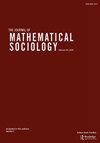并不是所有的桥都连接:多社区网络的集成
IF 1.3
4区 社会学
Q3 MATHEMATICS, INTERDISCIPLINARY APPLICATIONS
引用次数: 1
摘要
摘要本文研究了多社区网络的高效和稳定集成结构,与社区内的桥梁相比,在社区之间建立桥梁会产生额外的连接成本。在具有直接和间接效益的连接模型的基础上,我们表明,对于同质成本和效益参数,以及任意大小的社区,有效结构的直径总是不大于3。我们进一步证明,对于非平凡的情况,积分总是遵循这三种结构中的一种:单星、两个集线器连接的星,以及我们在本文中引入的一种新结构,即平行超星,这是一种特殊的核心/外围结构,具有连接不同社区核心节点的平行桥。然后,我们使用标准成对稳定性和转移后成对稳定性来研究这些结构的稳定性条件,这是我们在本文中引入的一个新的稳定性概念,允许双边效用转移。我们证明,虽然平行超星结构永远不可能既有效又成对稳定,但一旦使用了后转移成对稳定性,效率就保证了稳定性。此外,我们证明了所有可能的有效结构都可以同时在转移后成对稳定。最后,我们给出了一些数值结果,并对经验证据进行了讨论。本文章由计算机程序翻译,如有差异,请以英文原文为准。
Not all bridges connect: integration in multi-community networks
ABSTRACT This paper studies structures for efficient and stable integration of multi-community networks where establishing bridges across communities incur additional link cost compared to those within communities. Building on the connections models with direct and indirect benefits, we show that the efficient structure for homogeneous cost and benefit parameters, and for communities of arbitrary size, always has a diameter no greater than 3. We further show that for non-trivial cases, integration always follows one of these three structures: single star, two hub-connected stars, and a new structure we introduce in this paper as parallel hyperstar, which is a special core/periphery structure with parallel bridges that connect the core nodes of different communities. Then we investigate stability conditions of these structures, using the standard pairwise stability, as well as post-transfer pairwise stability, a new stability notion we introduce in this paper, which allows for bilateral utility transfers. We show that while the parallel hyperstar structure can never be both efficient and pairwise stable, once post-transfer pairwise stability is used, efficiency guarantees stability. Furthermore, we show that all possible efficient structures can be simultaneously post-transfer pairwise stable. In the end, we provide some numerical results and discussion of empirical evidences.
求助全文
通过发布文献求助,成功后即可免费获取论文全文。
去求助
来源期刊

Journal of Mathematical Sociology
数学-数学跨学科应用
CiteScore
2.90
自引率
10.00%
发文量
5
审稿时长
>12 weeks
期刊介绍:
The goal of the Journal of Mathematical Sociology is to publish models and mathematical techniques that would likely be useful to professional sociologists. The Journal also welcomes papers of mutual interest to social scientists and other social and behavioral scientists, as well as papers by non-social scientists that may encourage fruitful connections between sociology and other disciplines. Reviews of new or developing areas of mathematics and mathematical modeling that may have significant applications in sociology will also be considered.
The Journal of Mathematical Sociology is published in association with the International Network for Social Network Analysis, the Japanese Association for Mathematical Sociology, the Mathematical Sociology Section of the American Sociological Association, and the Methodology Section of the American Sociological Association.
 求助内容:
求助内容: 应助结果提醒方式:
应助结果提醒方式:


